Interested in Japanese culture and way of doing things? Well, here’s a lesson on what Japanese say before eating. Read on to find out!
In Japanese, the meal is known as ‘gohan’, and the word actually refers to steamed rice. Since rice is such an important part of Japanese cuisine, the word started being taken as the common word for all meals.
The traditional Japanese meal contains a serving of plain, white rice, a main dish (meat or fish), a side dish (most often cooked vegetables), soup (miso soup or clear broth), and pickled vegetables.
The Japanese respect their mealtimes a lot, and they make sure that they show it. As a way of showing respect, Japanese people hold their hands to put their feelings and thoughts into form. This is the same hand gesture that is used by them when they are showing respect to their ancestors or to a kami. However, they can also skip joining hands and say a greeting instead.
Do you know what the Japanese say before eating? Continue reading to know all the meal phrases that they use when eating.
What Japanese Say Before eating?
Before eating, it is common in Japanese culture to say "itadakimasu" (いただきます). This phrase is used to express gratitude and appreciation for the food about to be consumed. It can be translated as "I humbly receive" or "Let's eat." Saying "itadakimasu" is a way to show respect for the meal, the efforts of the cook, and the ingredients used. It is a customary phrase used before starting a meal in Japan.
- Related: Why Japanese Don’t Speak English
- Related: Easy Japanese for Dining Out
- Related: Easy Japanese for Ordering Food
What does ‘Itadakimasu’ mean?
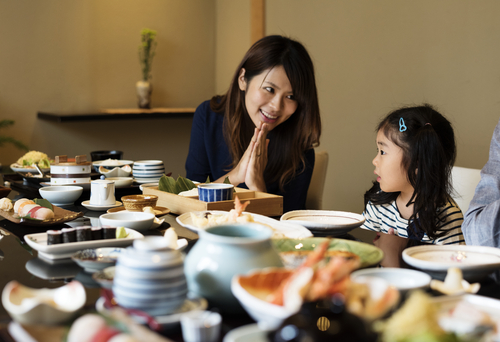
‘Itadakimasu’ is a polite form of the word ‘itadaku’. This is a word that indicates your modesty for receiving and eating the food. The origin of this word is from the Japanese kanji character, which really means ‘top of the head’.
This is a body position where you are kneeling down with bowed heads and arms extended upwards. This is a common posture that is shown when you are receiving something from a higher-ranking person.
It is also believed that the term originated from the custom of receiving an offering from a Buddhist alter. In this custom, just like when you are receiving something from a person at the higher rank, you need to receive it from above the head.
When the Japanese say ‘itadakimasu’, they are showing their gratefulness for the food they have received. By saying this phrase, you also thank the person who has cooked the food for you.
After saying this phrase, people take a bite from either the main dish or the side dish. Then, they take a little rice before finally having a soup straight from the bowl.
In Japan, people do not use spoons to drink soup. A little rice is usually left until the end of the meal so that it can be eaten with the pickled vegetables.
Related: Basic Japanese Words To Use
Gochisousama (ごちそうさま)
‘Gochisousama’ is a phrase that is used by the Japanese after they have finished the meal. It is a phrase that is used to again thank those who have prepared the meal. The phrase is written as 御馳走様 in Japanese kanji characters.
The word ‘Chiso’ means running. The reason why ‘running’ is used here is before a long time ago, people literally had to run to get their meals. People had to hunt, fish, and harvest to get their meals. They also had to bring together ingredients from many places to help them prepare their food.
So, the phrase is used to express gratitude to those who have done all the hard work of bringing together all the ingredients to put the meal in front of you.
The term ‘go’ is added in the phrase to show more respect. ‘Gochiso’ is a term that means a feastful and luxurious meal.
The term ‘Sama’ is a suffix that is added after a person’s name to show respect. By adding ‘sama’ to ‘Gochiso’, you are simply showing respect and gratitude to the person who has prepared the food for you.
When put together, all the words of the term ‘Gochisosama’ mean ‘Thank you very much for putting in so much effort in this delicious meal’.
If you are in Japan, make sure you are using this word after a meal. It really will make your hosts super happy.
Related: Why Learning Japanese is Difficult
Do you have to bring your palms together?
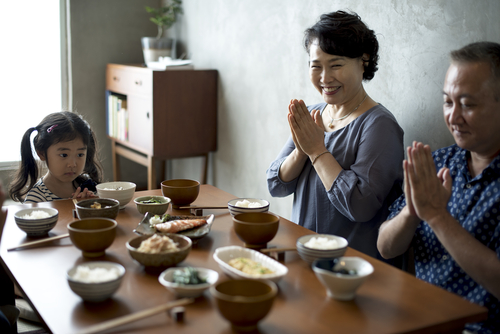
When the Japanese bring together their palms, it shows that they are showing respect, gratitude, and sincerity. This is a gesture that is done when starting and ending a meal. So, when you are saying ‘itadakimasu’ and ‘gochisosama’, it is advisable to bring together your palms to show that you are being respectful.
However, it is not a requirement. So if you do not feel very comfortable doing it, you can skip it and just say those phrases before and after the meal.
Other common Japanese Phrases That Are Used When Eating
There are several other phrases that are common in Japan when eating. Apart from ‘itadakimasu’ and ‘gochisosama’, knowing these phrases when eating in Japan can be quite useful too.
Okawari (おかわり) = More food please
The term ‘Okawari’ means ‘More food please’, and is a term that is used when you would want more of a particular dish. You may want to use this phrase if you are still hungry or because you really love that dish even if you cannot eat anymore.
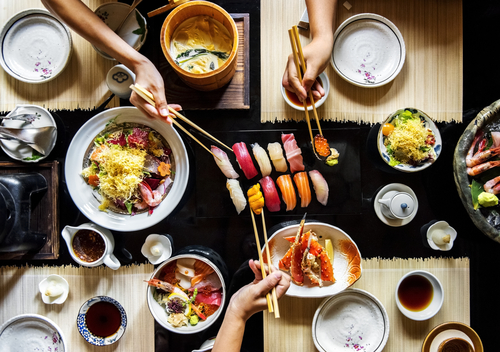
Also, in Japan, it is considered rude and disrespectful to leave food on your plate after eating. This is especially the case when you have asked for second helpings of the dish. And so, you need to be mindful of the amount you take. Always request the exact amount of the dish so that nothing is wasted.
Oishii (美味しい) = Tasty or Delicious
Oishii is a way of telling your hosts that the food is delicious. This is a great way to make the chef or the person who has cooked the food feel good.
When you say ‘Oishii’ while chewing your food, people you are eating with will feel pleased to know that you really are enjoying the food.
You can also say this to the chef of the person who has prepared the meal after you are finished eating. This will let them know that their food really made you feel happy.
Kekkou desu (けっこうです) = "No, thank you"
This is a polite way of saying ‘No, thank you’ when something is being served to you. If you do not wish to try out or eat a particular dish that you are unsure about, you can use this term. Also, when somebody is asking you if you would like more helpings of the food but you are already full, you can simply say this.
Onaka ga ippai (お腹がいっぱい) = "I'm full" or "My stomach is full."
Onaka ga ippai means ‘I am full’. This is a phrase to show that you have no more room left in your tummy for more food. You can also use this place when you are really full and cannot finish all the food on your plate. This is a very polite way of saying you cannot take in any more food and so have to leave it.
The phrases ‘kekkou desu’ and ‘onaka ga ippai’ work really well together. When combined, these phrases mean ‘ No, thank you. I am full.’
Japanese Eating Etiquette
Now that you are well aware of the phrases that are used when eating in Japan, it will not hurt to know about the table manners that you need to follow. So, here are some eating etiquette that the Japanese are particular about.
In Japanese culture, Food should never go above the mouth
When eating, never raise your chopsticks above your mouth level. That is the highest you should take your chopsticks. When eating, do not have a staring competition with the food.
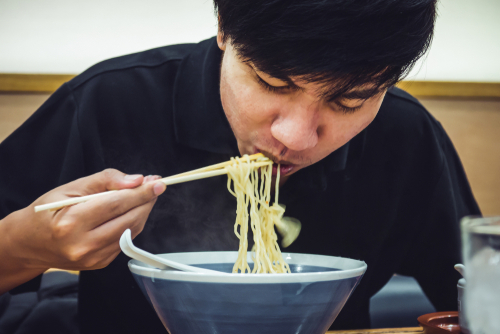
#2-- Your chopsticks should never rest on your bowl
If you use your bowl as the resting place for your chopstick, you are disrespecting Japanese eating etiquette. It may seem like the right thing to do, but believe me, it is not. If there is no chopstick rest, you can use the chopsticks wrapper to make your own chopstick rest. If that too is unavailable, you can simply use the side of a tray or any other similar item to rest your chopstick.
You should not use your hands to catch falling food
We are all guilty of doing that, right? I usually end up cupping my hand to catch any food that decides to escape my mouth and fall down. But in Japan, this is considered to be bad manners.
Slurping is acceptable and encouraged
You may have heard your entire life that slurping is rude or disgusting. You should not be too vocal in making sounds while eating. However, this is not the case in Japan. Here, you are encouraged to make slurping sounds when eating your noodles. This action shows that you are really enjoying the meal.
No spoon for soup
In Japan, they do not use spoons to slurp down the soup. Instead, you use chopsticks to eat all the solid bits in the soup. And for the broth, you simply bring the bowl to your lips and take sips.
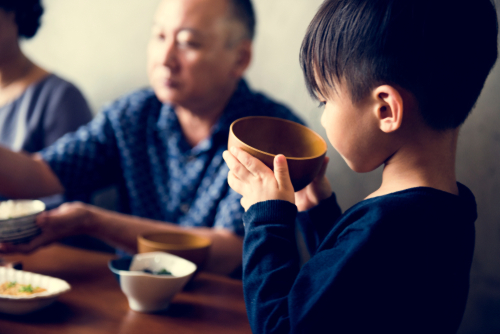
Use only as much soy sauce as is required
You must only pour yourself as much soy sauce as you require. Over serving is considered to be bad manners. However, it is advisable to leave a trace behind when you are done.
Use the chopsticks the right way
Use your chopsticks to hold your food, not to stab it. It is not a harpoon, and so, you need to be mindful about how you use it.
What Do Japanese Day Before Eating: FAQs
Do Japanese really say Itadakimasu?
Yes, Japanese people do say Itadakimasu before eating. It is a common Japanese phrase that is used to express gratitude for the food that is being eaten. Itadakimasu is a polite and humble way of saying "I humbly receive". It is thought to have originated from the Buddhist custom of receiving offerings from an altar.
Itadakimasu is often said in a group setting, such as at a restaurant or at home with family. It can also be said when eating alone. When saying Itadakimasu, it is customary to bow your head slightly.
There are a few reasons why Japanese people say Itadakimasu. First, it is a way of showing gratitude to the people who prepared the food. Second, it is a way of showing respect for the food itself. Third, it is a way of showing appreciation for the natural world that provides us with food.
Itadakimasu is a simple phrase, but it has a deep meaning. It is a way of expressing gratitude for the many things that make it possible for us to eat.
Do you say Itadakimasu by yourself?
Yes, it is common to say "itadakimasu" even if you are eating alone. The phrase is not only about expressing gratitude for the food but also about recognizing the interconnectedness of all beings involved in the process of providing the meal, including the farmers, cooks, and nature itself.
Therefore, even when dining alone, many people in Japan still say "itadakimasu" as a way of acknowledging the food and showing appreciation.
What is the response to Itadakimasu?
The typical response to "itadakimasu" is silence or a simple nod. In Japanese culture, it is not customary to respond verbally to "itadakimasu." Instead, it is generally observed as a moment of quiet acknowledgment and respect for the meal.
However, in more informal settings or among close friends and family, you may hear responses like "osoi desu" (おそいです, meaning "I'm starting late") or "itadakimasu, gochisousama" (いただきます、ごちそうさま, combining the pre-meal and post-meal phrases) exchanged between diners.
What is the full phrase of Itadakimasu?
The full phrase of "itadakimasu" is actually "Gochisousama-deshita, itadakimasu" (ごちそうさまでした、いただきます).
The phrase "gochisousama-deshita" is said after finishing a meal and expresses gratitude for the food that was provided. It can be translated as "Thank you for the feast" or "That was a delicious meal." It is a way of acknowledging and showing appreciation to the host or chef for their effort in preparing the meal.
Then, "itadakimasu" is said before starting the meal to express gratitude and respect for the food that is about to be eaten, as well as the effort put into its preparation.
So, when combined, the full phrase "Gochisousama-deshita, itadakimasu" encompasses both the appreciation for the completed meal and the reverence for the upcoming one.
What is the opposite of Itadakimasu?
The opposite of "itadakimasu" is "gochisousama deshita" (ごちそうさまでした). This phrase is typically said after finishing a meal and translates to "Thank you for the feast" or "That was a delicious meal."
It is a way of expressing gratitude and appreciation to the host, chef, or anyone involved in preparing the meal. While "itadakimasu" is said before starting a meal, "gochisousama deshita" is said at the end to acknowledge the food and show gratitude.
Is it rude not to say Itadakimasu?
In Japanese culture, it is generally considered polite to say "itadakimasu" before starting a meal, as it expresses gratitude and respect for the food. However, it is important to note that different situations and contexts may have varying expectations.
In more casual or informal settings, such as dining with close friends or family, the omission of "itadakimasu" may not be seen as rude or offensive. Nevertheless, it is still a customary practice and a way to show appreciation for the meal.
In formal or business settings, where etiquette and cultural norms are emphasized, it is generally expected to say "itadakimasu" as a gesture of politeness and respect.
Ultimately, while it is not necessarily rude to omit "itadakimasu," saying the phrase is considered a polite and respectful practice in Japanese culture.
What is an example of Itadakimasu?
Imagine a family sitting down for dinner together. Before starting to eat, one family member might say:
Person A: いただきます!(Itadakimasu!) - "Let's eat!/I humbly receive!"
This expresses gratitude and acknowledges the food and everyone involved in preparing the meal.
The other family members might respond with a simple nod or say nothing in response, as silence is often observed after "itadakimasu."
After enjoying the meal, at the end of the dinner, they might say:
Person B: ごちそうさまでした (Gochisousama deshita) - "Thank you for the feast."
This expresses gratitude and appreciation for the delicious meal and the efforts put into preparing it.
These phrases, "itadakimasu" and "gochisousama deshita," are commonly used in Japanese mealtime etiquette to show respect and gratitude for the food and the people involved in the meal.
Is it rude to burp after a meal in Japan?
In Japan, it is generally considered impolite to burp loudly or intentionally after a meal, as it is seen as a breach of good manners. Burping in public is considered disruptive and can be viewed as disrespectful to others around you.
In Japanese dining etiquette, it is preferred to eat quietly and avoid making loud noises during a meal. This includes refraining from burping loudly or making other disruptive sounds. It is considered more polite to suppress the urge to burp or do so discreetly, if necessary.
It's worth noting that cultural norms may vary, and there can be some exceptions in very informal settings or among close friends or family.
However, as a general rule, it is best to avoid loud or intentional burping after a meal in Japan to adhere to the cultural etiquette.
Do Japanese say Itadakimasu before drinking?
No, it is not common for Japanese individuals to say "itadakimasu" before drinking. The phrase "itadakimasu" is specifically used before starting a meal as a way to express gratitude and respect for the food.
It acknowledges the effort put into preparing the meal and shows appreciation for the sustenance being received.
When it comes to beverages, such as tea, water, or other drinks, there is no specific phrase like "itadakimasu" to be said before drinking.
However, it is still important to handle drinks with respect and proper manners while drinking, such as not making loud slurping sounds or being considerate of others.
What does arigato gozaimasu mean?
"Arigato gozaimasu" (ありがとうございます) is a polite and formal way to say "thank you" in Japanese. It is a common expression used to express gratitude and appreciation.
The phrase is a combination of "arigato" (ありがとう), which means "thank you," and "gozaimasu" (ございます), which is a polite form of the verb "to be."
When combined, "arigato gozaimasu" conveys a higher level of politeness and respect in expressing gratitude compared to the simpler "arigato."
It is commonly used in formal or professional settings, as well as in daily interactions with people who are not close acquaintances or friends.
Why do Japanese say lets eat?
Japanese people say "itadakimasu" before a meal to express gratitude, show respect for the food, promote social harmony, and observe proper etiquette.
What is the plain form of Itadakimasu?
The plain form of "itadakimasu" is "itadaku" (いただく). The plain form is often used in casual or informal situations, while "itadakimasu" is the more polite and formal version commonly used before a meal to express gratitude and respect.
Ready to dine in Japan?
Now that you are familiar with the whole process of using the right phrases before and after eating, and that you are also well-acquainted with the table manners, are you ready to go to Japan and enjoy your meals?




